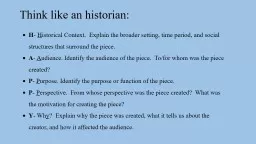

Think like an historian H H istorical Context Explain the broader setting time period and social structures that surround the piece A A udience Identify the audience of the piece Tofor whom was the piece created ID: 768606
Download Presentation The PPT/PDF document "Think like an historian:" is the property of its rightful owner. Permission is granted to download and print the materials on this web site for personal, non-commercial use only, and to display it on your personal computer provided you do not modify the materials and that you retain all copyright notices contained in the materials. By downloading content from our website, you accept the terms of this agreement.
Think like an historian: H - H istorical Context. Explain the broader setting, time period, and social structures that surround the piece. A - A udience . Identify the audience of the piece. To/for whom was the piece created? P - P urpose . Identify the purpose or function of the piece. P - P erspective . From whose perspective was the piece created? What was the motivation for creating the piece? Y - Wh y ? Explain why the piece was created, what it tells us about the creator, and how it affected the audience.
Early Mesopotamian ArtThe recording of history begins with the invention of writing in the ancient Near East. In Mesopotamia, large, urban areas centered on manmade mountains topped by temples. From these temples, priests sought to appease the gods. City-states were often threatened by other city-states, and by foreign invaders. Mesopotamian history is noted for its instability, and shifts in the balance of power. Despite the constant changes, two major characteristics are found in all Mesopotamian art: narrative and power. Art tells stories, often of the might and exploits of kings and men favored by the gods. Characteristics: The enduring architectural monument was the temple. Reflects the view of life in which human beings were meant to serve the gods, who were personified the powerful forces of nature. Strong fortifications were necessary. Depicting the power and authority of the king. Kings sensed that are could help glorify their reigns, and tell narratives that would last into the ages. Resulted in steles to commemorate military victories and laws – palaces to glorify. Hybrids of animals and men are common themes. Protective guardians and symbols of power. Deification of the king. The use of hierarchy of scale, composite figures, and registers. Use of whitewashed plaster, glazed tile, and paint on mud-brick buildings due to lack of good stone in region.
The Code of Hammurabi. Babylon (modern Iran). Susian . c. 1792–1750 B.C.E. Basalt. https:// www.khanacademy.org/humanities/ap-art-history/ancient-mediterranean-ap/ancient-near-east-a/v/stele-of-hammurabi
White Temple and its ziggurat. Uruk (modern Warka , Iraq). Sumerian. c. 3500–3000 B.C.E. Mud brick . https://www.khanacademy.org/humanities/ancient-art-civilizations/ancient-near-east1/sumerian/a/white-temple-and-ziggurat-uruk
A ziggurat is the massive platform that raises the temple above ground. The temple and ziggurat are considered different buildings. Temples were in the center of cities. Temples are dedicated to specific gods. This temple was probably dedicated to Anu , a sky god. The temple height created a belief that gods live above our world in the sky at night. Access to the structure was allowed only to the highest strata’s of society The corners of the ziggurat face the cardinal directions. It was made of mud brick. The sides were sealed with tar to protect from floods.
Lamassu from the citadel of Sargon II, Dur Sharrukin (modern Khorsabad , Iraq). Neo-Assyrian. c. 720–705 B.C.E. Alabaster . https://www.khanacademy.org/humanities/ancient-art-civilizations/ancient-near-east1/assyrian/v/lamassu The lamassu is a mythological creature that combines the head of a person with the body of a bull and wings of an eagle. These 13-feet tall statues appeared at the entrance gate of the citadel as a guardian. They represent the power and authority of the ruler. It was made to ward off the kings enemies The sculpture has five legs--to show movement.
Statues of votive figures, from the Square Temple at Eshnunna (modern Tell Asmar , Iraq). Sumerian.c . 2700 B.C.E. Gypsum inlaid with shell and black limestone . https://www.khanacademy.org/humanities/ancient-art-civilizations/ancient-near-east1/sumerian/v/standing-male-worshipper
The votive figures resemble a human praying or worshiping. Each votive figurine was made to represent one of the individuals of Sumer. Wealthy citizens commissioned votive figurine models to be placed in the temples of Sumer so the citizens would be seen well through the eyes of their gods. stylized, short, and compact. The arms are folded in a prayerful posture. The eyes are enlarged. The back is inscribed with “It offers prayers.” Hierarchal scale: the larger the figurine the more wealth or importance the person it was modeled after had. Patronism : the act of a wealthy person hiring an artist. Subtractive sculpture: The artist starts with cylindrical form or brick like form then carves away to reveal figure.
Standard of Ur from the Royal Tombs at Ur (modern Tell el-Muqayyar , Iraq). Sumerian. c. 2600–2400 B.C.E. Wood inlaid with shell, lapis lazuli, and red limestone . https://www.khanacademy.org/humanities/world-history/world-history-beginnings/ancient/v/standard-of-ur-c-2600-2400-b-c-e
The Standard of Ur, d iscovered in a tomb found within a royal cemetery, is constructed of wood with lapis lazuli inlays. Lapis lazuli is a precious stone reserved for only the wealthiest citizens. The stone had sacred value in the burial of the deceased. The front and backsides of the piece are referred to as panels , one depicting war and one depicting a sort of party scene. The panels are broken down into three correlating horizontal registers , which hint at the beginning of writing a story in chronological order. People are depicted in composite view . Hierarchal scale shows importance of persons through size. This piece is one of the earliest depictions of the Sumerian army. Within the army, many advances are displayed such as the wheel, animals pulling carts, and metal swords. The naked figures are thought of as a metaphor for defeat, not their literal state of being during the battle ..